London Olympics 2012: Budgeting, Costing, and Financial Analysis
VerifiedAdded on 2020/01/23
|11
|3304
|178
Report
AI Summary
This report provides a detailed financial analysis of the London Olympics 2012. It examines the project's financial structure, including the roles of ODA and LOCOG, and the sources of funding. The report highlights the significant over-budgeting, challenges faced, and cost control measures considered. It analyzes the financial performance, including inward investment and sales, and provides a critical review of funding sources, risk management, and project costing. The analysis covers the budgeting process, financial performance and challenges faced during the project. The report concludes with recommendations for improved cost control and financial planning, offering insights into the successful management of large-scale projects. The report also highlights the need for effective planning, risk management, and cost-control measures to ensure financial success, despite the challenges and overspending.

LONDON OLYMPICS 2012
PROJECT
PROJECT
Paraphrase This Document
Need a fresh take? Get an instant paraphrase of this document with our AI Paraphraser

Executive Summary
Maintenance of Olympics is a crucial tasks because it involves various parameters such
as financing according to the budget, providing quality services to the players, actual costings
involved and various other social plus environmental factors. This report has taken London
Olympics 2012 into consideration. The overall final budget exceeded the estimated budget by
approximately 10 USD billion. This was a major issue afterwards.
As per the findings of financial structure two main authorities were involved for
organising Games and they were ODA and LOCOG . However the government was responsible
for funding Olympics through private sectors. All the costings related to infrastructure, security,
players were funded separately. This meant that this budget could not be used for other activities
in London that is education etc.
Further in report another point emerges out that ODA had to complete all the venues
just 12 months before London Olympics. Various challenges came by in the way of ODA such
as recession etc. but with its highly skilled managing skills it emerged out successfully achieving
the aims and facing the challenges.
The report then throws light upon the various costings related to the Games which give
the idea that what could be the possible reasons for over budgeting. And further certain cost
control methods have been pondered upon. Despite the over budget the Olympics proved out to
be a successful event based on the findings of its financial performance.
In the end conclusion covers the understanding of the overall project. Recommendations
have also been provided on the basis findings of costing, budget, finance. These
recommendations can be considered by the authority for controlling over budgeting.
Maintenance of Olympics is a crucial tasks because it involves various parameters such
as financing according to the budget, providing quality services to the players, actual costings
involved and various other social plus environmental factors. This report has taken London
Olympics 2012 into consideration. The overall final budget exceeded the estimated budget by
approximately 10 USD billion. This was a major issue afterwards.
As per the findings of financial structure two main authorities were involved for
organising Games and they were ODA and LOCOG . However the government was responsible
for funding Olympics through private sectors. All the costings related to infrastructure, security,
players were funded separately. This meant that this budget could not be used for other activities
in London that is education etc.
Further in report another point emerges out that ODA had to complete all the venues
just 12 months before London Olympics. Various challenges came by in the way of ODA such
as recession etc. but with its highly skilled managing skills it emerged out successfully achieving
the aims and facing the challenges.
The report then throws light upon the various costings related to the Games which give
the idea that what could be the possible reasons for over budgeting. And further certain cost
control methods have been pondered upon. Despite the over budget the Olympics proved out to
be a successful event based on the findings of its financial performance.
In the end conclusion covers the understanding of the overall project. Recommendations
have also been provided on the basis findings of costing, budget, finance. These
recommendations can be considered by the authority for controlling over budgeting.
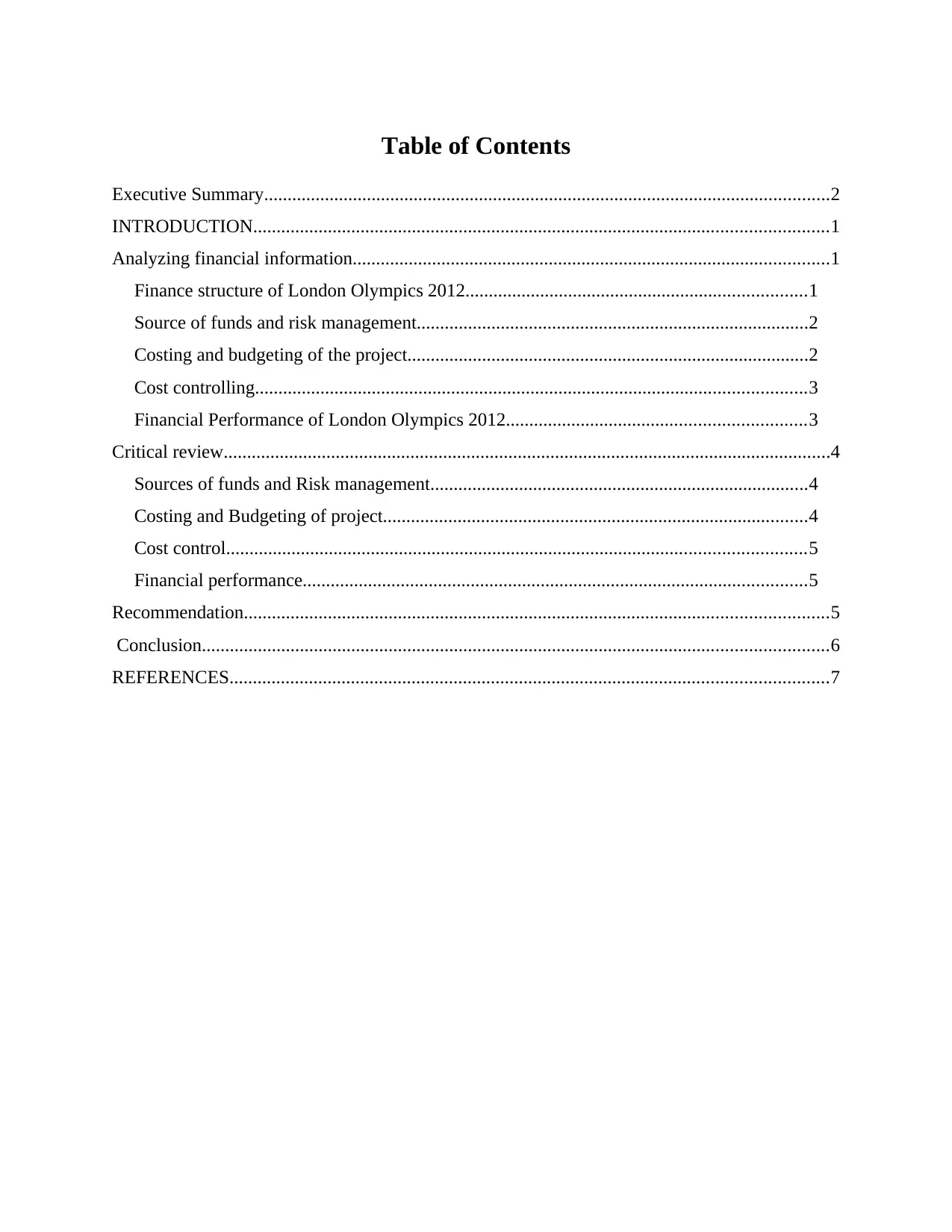
Table of Contents
Executive Summary.........................................................................................................................2
INTRODUCTION...........................................................................................................................1
Analyzing financial information......................................................................................................1
Finance structure of London Olympics 2012.........................................................................1
Source of funds and risk management....................................................................................2
Costing and budgeting of the project......................................................................................2
Cost controlling......................................................................................................................3
Financial Performance of London Olympics 2012................................................................3
Critical review..................................................................................................................................4
Sources of funds and Risk management.................................................................................4
Costing and Budgeting of project...........................................................................................4
Cost control............................................................................................................................5
Financial performance............................................................................................................5
Recommendation.............................................................................................................................5
Conclusion......................................................................................................................................6
REFERENCES................................................................................................................................7
Executive Summary.........................................................................................................................2
INTRODUCTION...........................................................................................................................1
Analyzing financial information......................................................................................................1
Finance structure of London Olympics 2012.........................................................................1
Source of funds and risk management....................................................................................2
Costing and budgeting of the project......................................................................................2
Cost controlling......................................................................................................................3
Financial Performance of London Olympics 2012................................................................3
Critical review..................................................................................................................................4
Sources of funds and Risk management.................................................................................4
Costing and Budgeting of project...........................................................................................4
Cost control............................................................................................................................5
Financial performance............................................................................................................5
Recommendation.............................................................................................................................5
Conclusion......................................................................................................................................6
REFERENCES................................................................................................................................7
⊘ This is a preview!⊘
Do you want full access?
Subscribe today to unlock all pages.

Trusted by 1+ million students worldwide
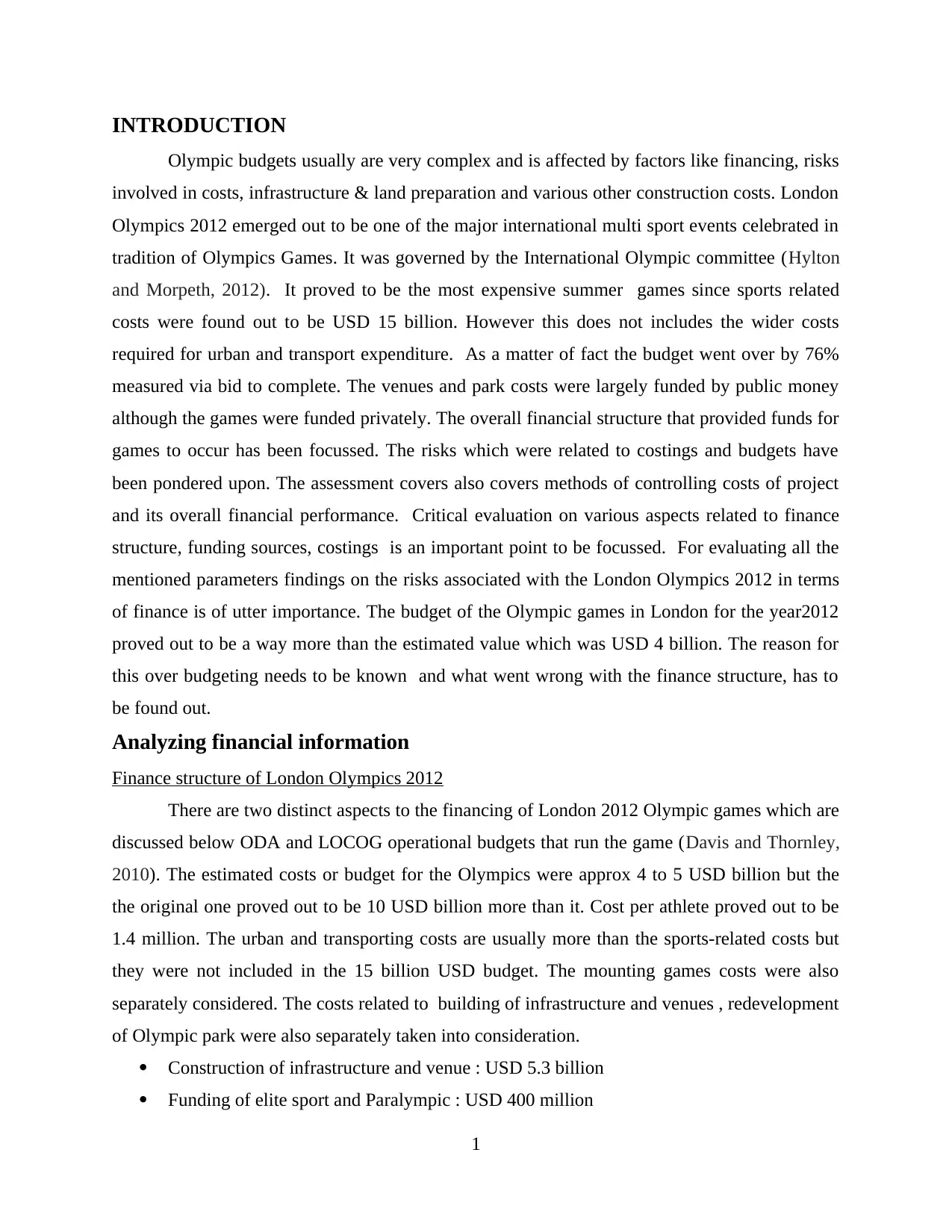
INTRODUCTION
Olympic budgets usually are very complex and is affected by factors like financing, risks
involved in costs, infrastructure & land preparation and various other construction costs. London
Olympics 2012 emerged out to be one of the major international multi sport events celebrated in
tradition of Olympics Games. It was governed by the International Olympic committee (Hylton
and Morpeth, 2012). It proved to be the most expensive summer games since sports related
costs were found out to be USD 15 billion. However this does not includes the wider costs
required for urban and transport expenditure. As a matter of fact the budget went over by 76%
measured via bid to complete. The venues and park costs were largely funded by public money
although the games were funded privately. The overall financial structure that provided funds for
games to occur has been focussed. The risks which were related to costings and budgets have
been pondered upon. The assessment covers also covers methods of controlling costs of project
and its overall financial performance. Critical evaluation on various aspects related to finance
structure, funding sources, costings is an important point to be focussed. For evaluating all the
mentioned parameters findings on the risks associated with the London Olympics 2012 in terms
of finance is of utter importance. The budget of the Olympic games in London for the year2012
proved out to be a way more than the estimated value which was USD 4 billion. The reason for
this over budgeting needs to be known and what went wrong with the finance structure, has to
be found out.
Analyzing financial information
Finance structure of London Olympics 2012
There are two distinct aspects to the financing of London 2012 Olympic games which are
discussed below ODA and LOCOG operational budgets that run the game (Davis and Thornley,
2010). The estimated costs or budget for the Olympics were approx 4 to 5 USD billion but the
the original one proved out to be 10 USD billion more than it. Cost per athlete proved out to be
1.4 million. The urban and transporting costs are usually more than the sports-related costs but
they were not included in the 15 billion USD budget. The mounting games costs were also
separately considered. The costs related to building of infrastructure and venues , redevelopment
of Olympic park were also separately taken into consideration.
Construction of infrastructure and venue : USD 5.3 billion
Funding of elite sport and Paralympic : USD 400 million
1
Olympic budgets usually are very complex and is affected by factors like financing, risks
involved in costs, infrastructure & land preparation and various other construction costs. London
Olympics 2012 emerged out to be one of the major international multi sport events celebrated in
tradition of Olympics Games. It was governed by the International Olympic committee (Hylton
and Morpeth, 2012). It proved to be the most expensive summer games since sports related
costs were found out to be USD 15 billion. However this does not includes the wider costs
required for urban and transport expenditure. As a matter of fact the budget went over by 76%
measured via bid to complete. The venues and park costs were largely funded by public money
although the games were funded privately. The overall financial structure that provided funds for
games to occur has been focussed. The risks which were related to costings and budgets have
been pondered upon. The assessment covers also covers methods of controlling costs of project
and its overall financial performance. Critical evaluation on various aspects related to finance
structure, funding sources, costings is an important point to be focussed. For evaluating all the
mentioned parameters findings on the risks associated with the London Olympics 2012 in terms
of finance is of utter importance. The budget of the Olympic games in London for the year2012
proved out to be a way more than the estimated value which was USD 4 billion. The reason for
this over budgeting needs to be known and what went wrong with the finance structure, has to
be found out.
Analyzing financial information
Finance structure of London Olympics 2012
There are two distinct aspects to the financing of London 2012 Olympic games which are
discussed below ODA and LOCOG operational budgets that run the game (Davis and Thornley,
2010). The estimated costs or budget for the Olympics were approx 4 to 5 USD billion but the
the original one proved out to be 10 USD billion more than it. Cost per athlete proved out to be
1.4 million. The urban and transporting costs are usually more than the sports-related costs but
they were not included in the 15 billion USD budget. The mounting games costs were also
separately considered. The costs related to building of infrastructure and venues , redevelopment
of Olympic park were also separately taken into consideration.
Construction of infrastructure and venue : USD 5.3 billion
Funding of elite sport and Paralympic : USD 400 million
1
Paraphrase This Document
Need a fresh take? Get an instant paraphrase of this document with our AI Paraphraser
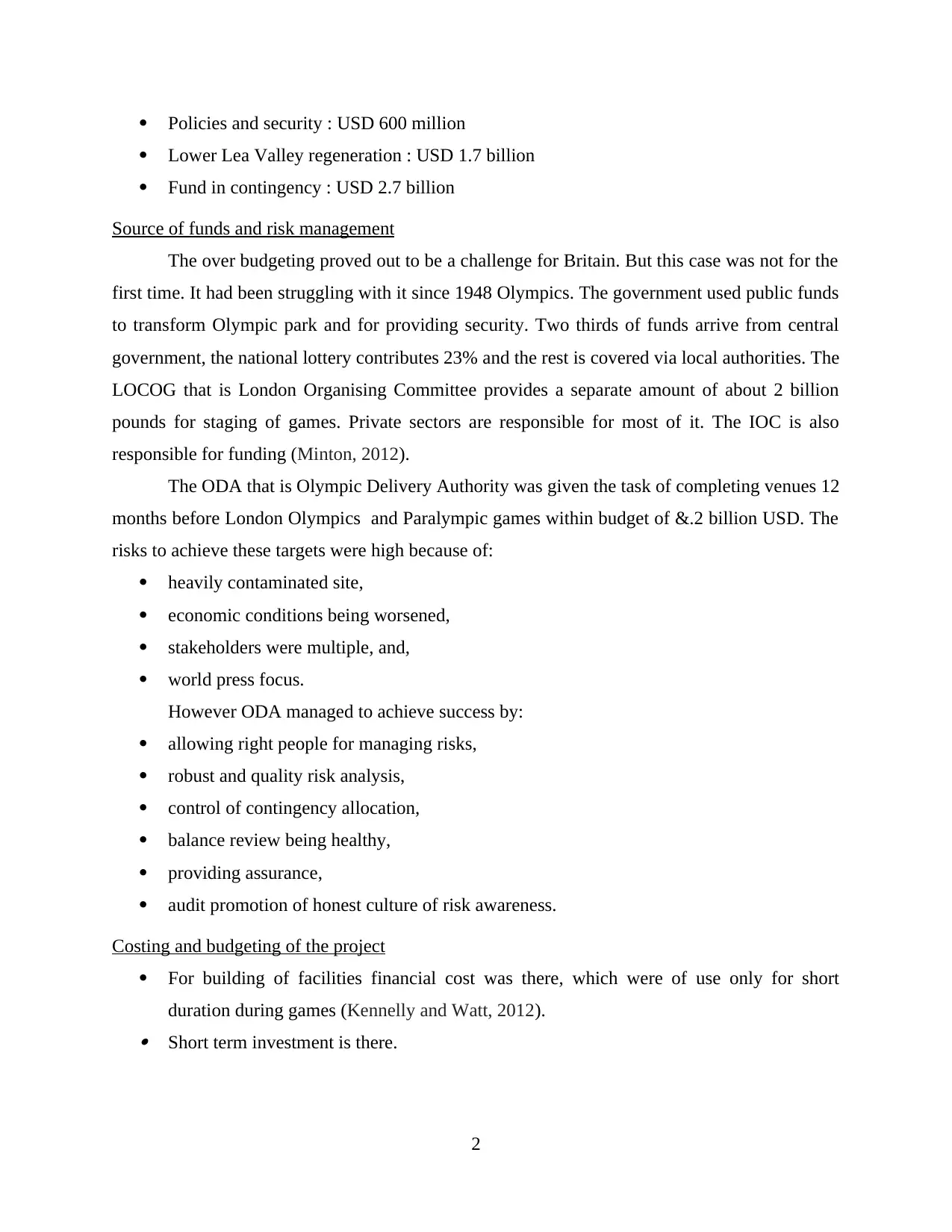
Policies and security : USD 600 million
Lower Lea Valley regeneration : USD 1.7 billion
Fund in contingency : USD 2.7 billion
Source of funds and risk management
The over budgeting proved out to be a challenge for Britain. But this case was not for the
first time. It had been struggling with it since 1948 Olympics. The government used public funds
to transform Olympic park and for providing security. Two thirds of funds arrive from central
government, the national lottery contributes 23% and the rest is covered via local authorities. The
LOCOG that is London Organising Committee provides a separate amount of about 2 billion
pounds for staging of games. Private sectors are responsible for most of it. The IOC is also
responsible for funding (Minton, 2012).
The ODA that is Olympic Delivery Authority was given the task of completing venues 12
months before London Olympics and Paralympic games within budget of &.2 billion USD. The
risks to achieve these targets were high because of:
heavily contaminated site,
economic conditions being worsened,
stakeholders were multiple, and,
world press focus.
However ODA managed to achieve success by:
allowing right people for managing risks,
robust and quality risk analysis,
control of contingency allocation,
balance review being healthy,
providing assurance,
audit promotion of honest culture of risk awareness.
Costing and budgeting of the project
For building of facilities financial cost was there, which were of use only for short
duration during games (Kennelly and Watt, 2012). Short term investment is there.
2
Lower Lea Valley regeneration : USD 1.7 billion
Fund in contingency : USD 2.7 billion
Source of funds and risk management
The over budgeting proved out to be a challenge for Britain. But this case was not for the
first time. It had been struggling with it since 1948 Olympics. The government used public funds
to transform Olympic park and for providing security. Two thirds of funds arrive from central
government, the national lottery contributes 23% and the rest is covered via local authorities. The
LOCOG that is London Organising Committee provides a separate amount of about 2 billion
pounds for staging of games. Private sectors are responsible for most of it. The IOC is also
responsible for funding (Minton, 2012).
The ODA that is Olympic Delivery Authority was given the task of completing venues 12
months before London Olympics and Paralympic games within budget of &.2 billion USD. The
risks to achieve these targets were high because of:
heavily contaminated site,
economic conditions being worsened,
stakeholders were multiple, and,
world press focus.
However ODA managed to achieve success by:
allowing right people for managing risks,
robust and quality risk analysis,
control of contingency allocation,
balance review being healthy,
providing assurance,
audit promotion of honest culture of risk awareness.
Costing and budgeting of the project
For building of facilities financial cost was there, which were of use only for short
duration during games (Kennelly and Watt, 2012). Short term investment is there.
2
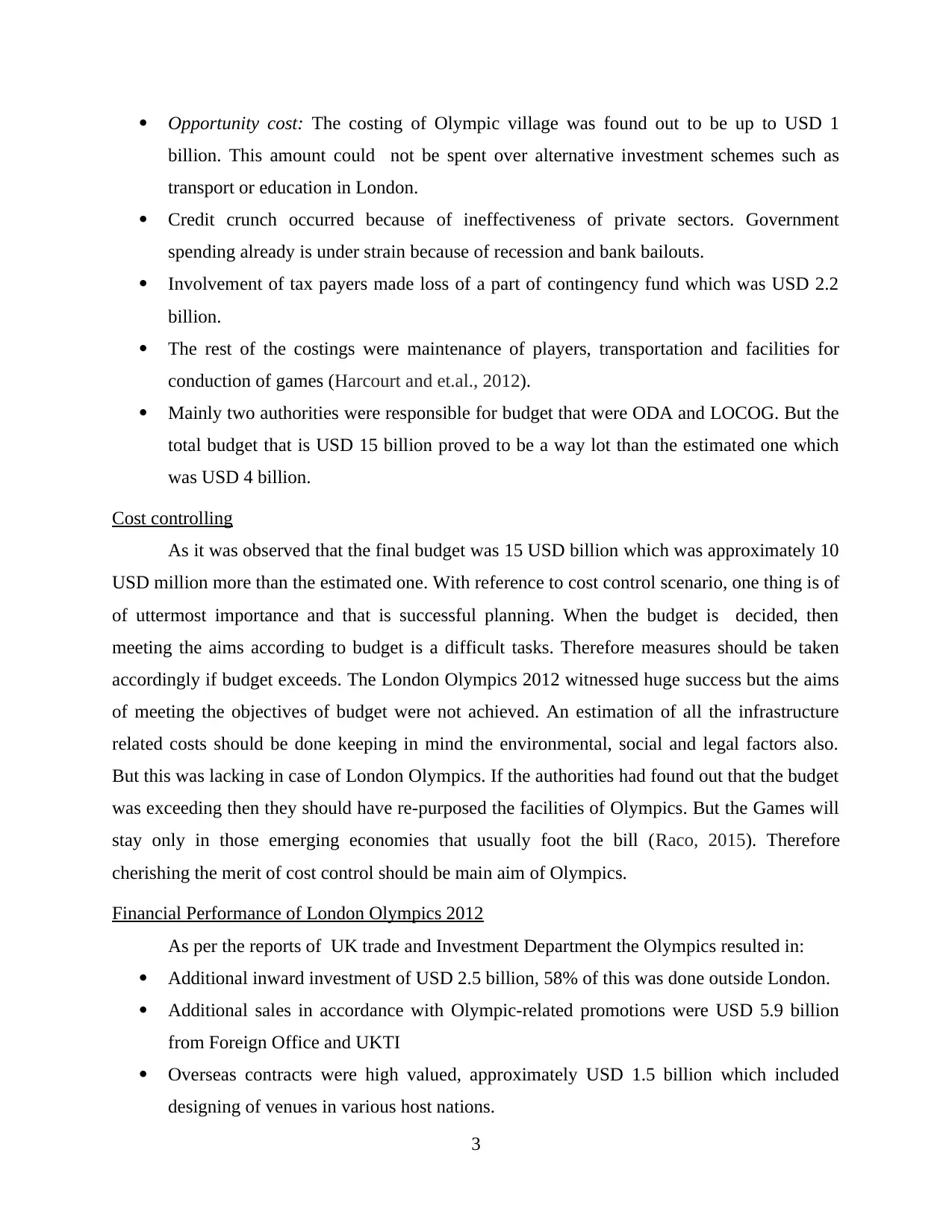
Opportunity cost: The costing of Olympic village was found out to be up to USD 1
billion. This amount could not be spent over alternative investment schemes such as
transport or education in London.
Credit crunch occurred because of ineffectiveness of private sectors. Government
spending already is under strain because of recession and bank bailouts.
Involvement of tax payers made loss of a part of contingency fund which was USD 2.2
billion.
The rest of the costings were maintenance of players, transportation and facilities for
conduction of games (Harcourt and et.al., 2012).
Mainly two authorities were responsible for budget that were ODA and LOCOG. But the
total budget that is USD 15 billion proved to be a way lot than the estimated one which
was USD 4 billion.
Cost controlling
As it was observed that the final budget was 15 USD billion which was approximately 10
USD million more than the estimated one. With reference to cost control scenario, one thing is of
of uttermost importance and that is successful planning. When the budget is decided, then
meeting the aims according to budget is a difficult tasks. Therefore measures should be taken
accordingly if budget exceeds. The London Olympics 2012 witnessed huge success but the aims
of meeting the objectives of budget were not achieved. An estimation of all the infrastructure
related costs should be done keeping in mind the environmental, social and legal factors also.
But this was lacking in case of London Olympics. If the authorities had found out that the budget
was exceeding then they should have re-purposed the facilities of Olympics. But the Games will
stay only in those emerging economies that usually foot the bill (Raco, 2015). Therefore
cherishing the merit of cost control should be main aim of Olympics.
Financial Performance of London Olympics 2012
As per the reports of UK trade and Investment Department the Olympics resulted in:
Additional inward investment of USD 2.5 billion, 58% of this was done outside London.
Additional sales in accordance with Olympic-related promotions were USD 5.9 billion
from Foreign Office and UKTI
Overseas contracts were high valued, approximately USD 1.5 billion which included
designing of venues in various host nations.
3
billion. This amount could not be spent over alternative investment schemes such as
transport or education in London.
Credit crunch occurred because of ineffectiveness of private sectors. Government
spending already is under strain because of recession and bank bailouts.
Involvement of tax payers made loss of a part of contingency fund which was USD 2.2
billion.
The rest of the costings were maintenance of players, transportation and facilities for
conduction of games (Harcourt and et.al., 2012).
Mainly two authorities were responsible for budget that were ODA and LOCOG. But the
total budget that is USD 15 billion proved to be a way lot than the estimated one which
was USD 4 billion.
Cost controlling
As it was observed that the final budget was 15 USD billion which was approximately 10
USD million more than the estimated one. With reference to cost control scenario, one thing is of
of uttermost importance and that is successful planning. When the budget is decided, then
meeting the aims according to budget is a difficult tasks. Therefore measures should be taken
accordingly if budget exceeds. The London Olympics 2012 witnessed huge success but the aims
of meeting the objectives of budget were not achieved. An estimation of all the infrastructure
related costs should be done keeping in mind the environmental, social and legal factors also.
But this was lacking in case of London Olympics. If the authorities had found out that the budget
was exceeding then they should have re-purposed the facilities of Olympics. But the Games will
stay only in those emerging economies that usually foot the bill (Raco, 2015). Therefore
cherishing the merit of cost control should be main aim of Olympics.
Financial Performance of London Olympics 2012
As per the reports of UK trade and Investment Department the Olympics resulted in:
Additional inward investment of USD 2.5 billion, 58% of this was done outside London.
Additional sales in accordance with Olympic-related promotions were USD 5.9 billion
from Foreign Office and UKTI
Overseas contracts were high valued, approximately USD 1.5 billion which included
designing of venues in various host nations.
3
⊘ This is a preview!⊘
Do you want full access?
Subscribe today to unlock all pages.

Trusted by 1+ million students worldwide
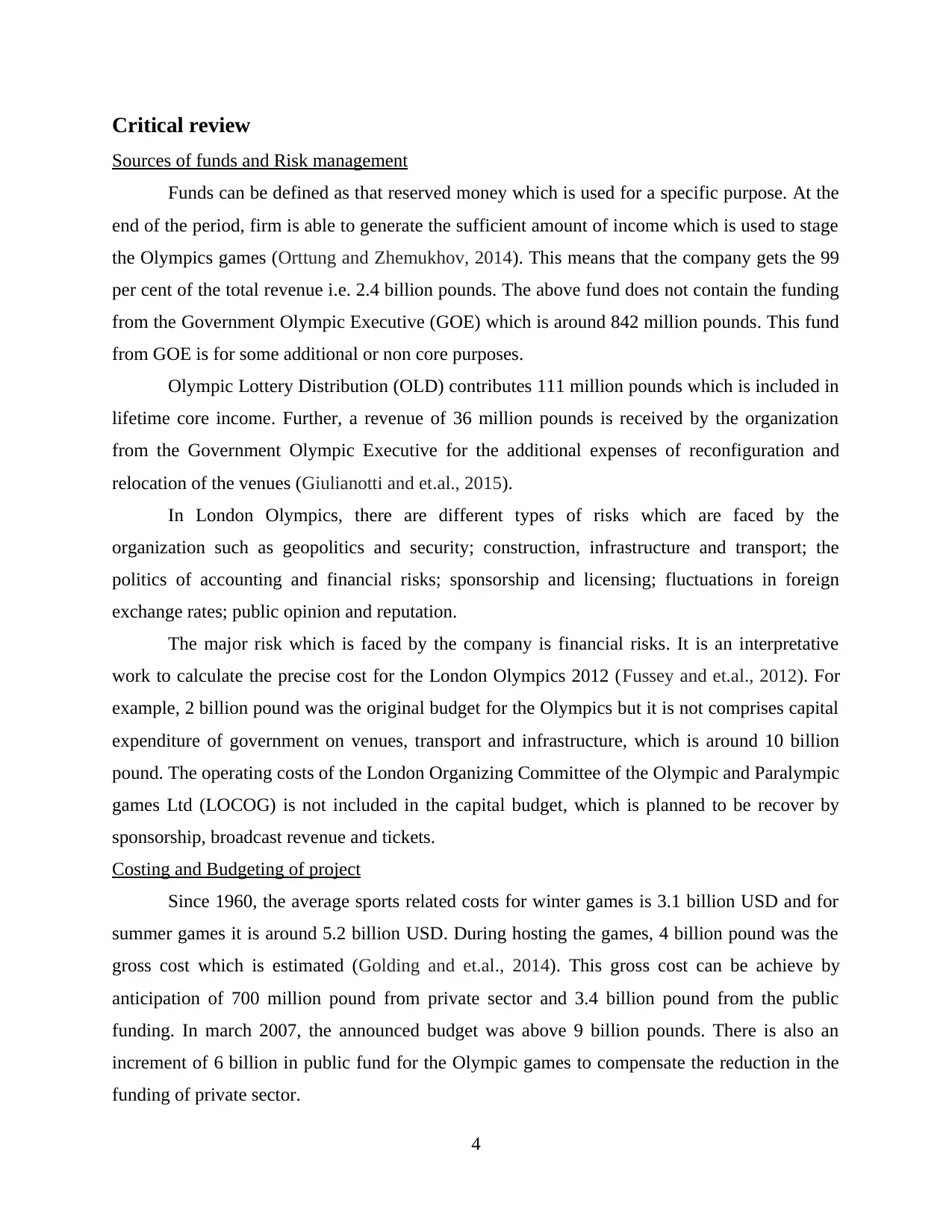
Critical review
Sources of funds and Risk management
Funds can be defined as that reserved money which is used for a specific purpose. At the
end of the period, firm is able to generate the sufficient amount of income which is used to stage
the Olympics games (Orttung and Zhemukhov, 2014). This means that the company gets the 99
per cent of the total revenue i.e. 2.4 billion pounds. The above fund does not contain the funding
from the Government Olympic Executive (GOE) which is around 842 million pounds. This fund
from GOE is for some additional or non core purposes.
Olympic Lottery Distribution (OLD) contributes 111 million pounds which is included in
lifetime core income. Further, a revenue of 36 million pounds is received by the organization
from the Government Olympic Executive for the additional expenses of reconfiguration and
relocation of the venues (Giulianotti and et.al., 2015).
In London Olympics, there are different types of risks which are faced by the
organization such as geopolitics and security; construction, infrastructure and transport; the
politics of accounting and financial risks; sponsorship and licensing; fluctuations in foreign
exchange rates; public opinion and reputation.
The major risk which is faced by the company is financial risks. It is an interpretative
work to calculate the precise cost for the London Olympics 2012 (Fussey and et.al., 2012). For
example, 2 billion pound was the original budget for the Olympics but it is not comprises capital
expenditure of government on venues, transport and infrastructure, which is around 10 billion
pound. The operating costs of the London Organizing Committee of the Olympic and Paralympic
games Ltd (LOCOG) is not included in the capital budget, which is planned to be recover by
sponsorship, broadcast revenue and tickets.
Costing and Budgeting of project
Since 1960, the average sports related costs for winter games is 3.1 billion USD and for
summer games it is around 5.2 billion USD. During hosting the games, 4 billion pound was the
gross cost which is estimated (Golding and et.al., 2014). This gross cost can be achieve by
anticipation of 700 million pound from private sector and 3.4 billion pound from the public
funding. In march 2007, the announced budget was above 9 billion pounds. There is also an
increment of 6 billion in public fund for the Olympic games to compensate the reduction in the
funding of private sector.
4
Sources of funds and Risk management
Funds can be defined as that reserved money which is used for a specific purpose. At the
end of the period, firm is able to generate the sufficient amount of income which is used to stage
the Olympics games (Orttung and Zhemukhov, 2014). This means that the company gets the 99
per cent of the total revenue i.e. 2.4 billion pounds. The above fund does not contain the funding
from the Government Olympic Executive (GOE) which is around 842 million pounds. This fund
from GOE is for some additional or non core purposes.
Olympic Lottery Distribution (OLD) contributes 111 million pounds which is included in
lifetime core income. Further, a revenue of 36 million pounds is received by the organization
from the Government Olympic Executive for the additional expenses of reconfiguration and
relocation of the venues (Giulianotti and et.al., 2015).
In London Olympics, there are different types of risks which are faced by the
organization such as geopolitics and security; construction, infrastructure and transport; the
politics of accounting and financial risks; sponsorship and licensing; fluctuations in foreign
exchange rates; public opinion and reputation.
The major risk which is faced by the company is financial risks. It is an interpretative
work to calculate the precise cost for the London Olympics 2012 (Fussey and et.al., 2012). For
example, 2 billion pound was the original budget for the Olympics but it is not comprises capital
expenditure of government on venues, transport and infrastructure, which is around 10 billion
pound. The operating costs of the London Organizing Committee of the Olympic and Paralympic
games Ltd (LOCOG) is not included in the capital budget, which is planned to be recover by
sponsorship, broadcast revenue and tickets.
Costing and Budgeting of project
Since 1960, the average sports related costs for winter games is 3.1 billion USD and for
summer games it is around 5.2 billion USD. During hosting the games, 4 billion pound was the
gross cost which is estimated (Golding and et.al., 2014). This gross cost can be achieve by
anticipation of 700 million pound from private sector and 3.4 billion pound from the public
funding. In march 2007, the announced budget was above 9 billion pounds. There is also an
increment of 6 billion in public fund for the Olympic games to compensate the reduction in the
funding of private sector.
4
Paraphrase This Document
Need a fresh take? Get an instant paraphrase of this document with our AI Paraphraser
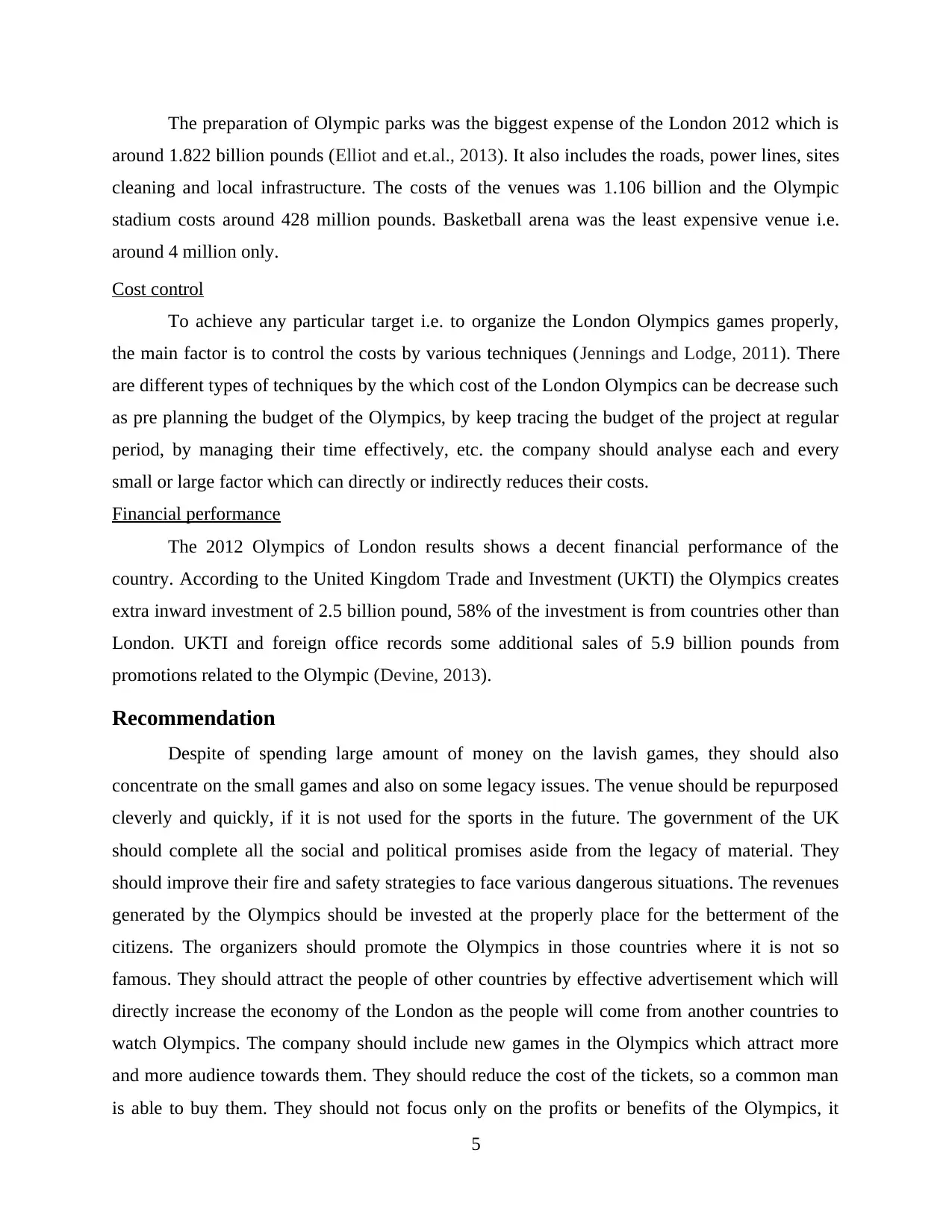
The preparation of Olympic parks was the biggest expense of the London 2012 which is
around 1.822 billion pounds (Elliot and et.al., 2013). It also includes the roads, power lines, sites
cleaning and local infrastructure. The costs of the venues was 1.106 billion and the Olympic
stadium costs around 428 million pounds. Basketball arena was the least expensive venue i.e.
around 4 million only.
Cost control
To achieve any particular target i.e. to organize the London Olympics games properly,
the main factor is to control the costs by various techniques (Jennings and Lodge, 2011). There
are different types of techniques by the which cost of the London Olympics can be decrease such
as pre planning the budget of the Olympics, by keep tracing the budget of the project at regular
period, by managing their time effectively, etc. the company should analyse each and every
small or large factor which can directly or indirectly reduces their costs.
Financial performance
The 2012 Olympics of London results shows a decent financial performance of the
country. According to the United Kingdom Trade and Investment (UKTI) the Olympics creates
extra inward investment of 2.5 billion pound, 58% of the investment is from countries other than
London. UKTI and foreign office records some additional sales of 5.9 billion pounds from
promotions related to the Olympic (Devine, 2013).
Recommendation
Despite of spending large amount of money on the lavish games, they should also
concentrate on the small games and also on some legacy issues. The venue should be repurposed
cleverly and quickly, if it is not used for the sports in the future. The government of the UK
should complete all the social and political promises aside from the legacy of material. They
should improve their fire and safety strategies to face various dangerous situations. The revenues
generated by the Olympics should be invested at the properly place for the betterment of the
citizens. The organizers should promote the Olympics in those countries where it is not so
famous. They should attract the people of other countries by effective advertisement which will
directly increase the economy of the London as the people will come from another countries to
watch Olympics. The company should include new games in the Olympics which attract more
and more audience towards them. They should reduce the cost of the tickets, so a common man
is able to buy them. They should not focus only on the profits or benefits of the Olympics, it
5
around 1.822 billion pounds (Elliot and et.al., 2013). It also includes the roads, power lines, sites
cleaning and local infrastructure. The costs of the venues was 1.106 billion and the Olympic
stadium costs around 428 million pounds. Basketball arena was the least expensive venue i.e.
around 4 million only.
Cost control
To achieve any particular target i.e. to organize the London Olympics games properly,
the main factor is to control the costs by various techniques (Jennings and Lodge, 2011). There
are different types of techniques by the which cost of the London Olympics can be decrease such
as pre planning the budget of the Olympics, by keep tracing the budget of the project at regular
period, by managing their time effectively, etc. the company should analyse each and every
small or large factor which can directly or indirectly reduces their costs.
Financial performance
The 2012 Olympics of London results shows a decent financial performance of the
country. According to the United Kingdom Trade and Investment (UKTI) the Olympics creates
extra inward investment of 2.5 billion pound, 58% of the investment is from countries other than
London. UKTI and foreign office records some additional sales of 5.9 billion pounds from
promotions related to the Olympic (Devine, 2013).
Recommendation
Despite of spending large amount of money on the lavish games, they should also
concentrate on the small games and also on some legacy issues. The venue should be repurposed
cleverly and quickly, if it is not used for the sports in the future. The government of the UK
should complete all the social and political promises aside from the legacy of material. They
should improve their fire and safety strategies to face various dangerous situations. The revenues
generated by the Olympics should be invested at the properly place for the betterment of the
citizens. The organizers should promote the Olympics in those countries where it is not so
famous. They should attract the people of other countries by effective advertisement which will
directly increase the economy of the London as the people will come from another countries to
watch Olympics. The company should include new games in the Olympics which attract more
and more audience towards them. They should reduce the cost of the tickets, so a common man
is able to buy them. They should not focus only on the profits or benefits of the Olympics, it
5
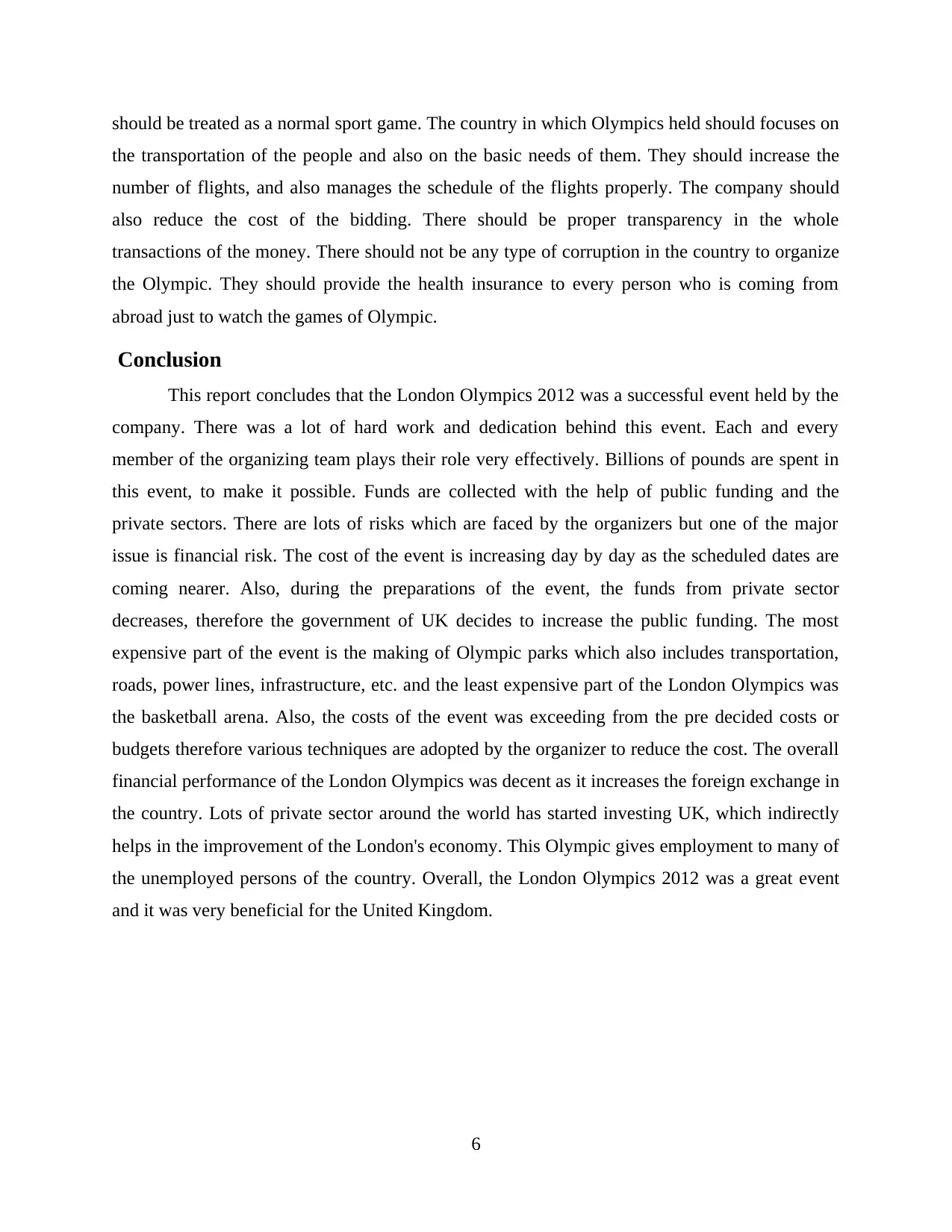
should be treated as a normal sport game. The country in which Olympics held should focuses on
the transportation of the people and also on the basic needs of them. They should increase the
number of flights, and also manages the schedule of the flights properly. The company should
also reduce the cost of the bidding. There should be proper transparency in the whole
transactions of the money. There should not be any type of corruption in the country to organize
the Olympic. They should provide the health insurance to every person who is coming from
abroad just to watch the games of Olympic.
Conclusion
This report concludes that the London Olympics 2012 was a successful event held by the
company. There was a lot of hard work and dedication behind this event. Each and every
member of the organizing team plays their role very effectively. Billions of pounds are spent in
this event, to make it possible. Funds are collected with the help of public funding and the
private sectors. There are lots of risks which are faced by the organizers but one of the major
issue is financial risk. The cost of the event is increasing day by day as the scheduled dates are
coming nearer. Also, during the preparations of the event, the funds from private sector
decreases, therefore the government of UK decides to increase the public funding. The most
expensive part of the event is the making of Olympic parks which also includes transportation,
roads, power lines, infrastructure, etc. and the least expensive part of the London Olympics was
the basketball arena. Also, the costs of the event was exceeding from the pre decided costs or
budgets therefore various techniques are adopted by the organizer to reduce the cost. The overall
financial performance of the London Olympics was decent as it increases the foreign exchange in
the country. Lots of private sector around the world has started investing UK, which indirectly
helps in the improvement of the London's economy. This Olympic gives employment to many of
the unemployed persons of the country. Overall, the London Olympics 2012 was a great event
and it was very beneficial for the United Kingdom.
6
the transportation of the people and also on the basic needs of them. They should increase the
number of flights, and also manages the schedule of the flights properly. The company should
also reduce the cost of the bidding. There should be proper transparency in the whole
transactions of the money. There should not be any type of corruption in the country to organize
the Olympic. They should provide the health insurance to every person who is coming from
abroad just to watch the games of Olympic.
Conclusion
This report concludes that the London Olympics 2012 was a successful event held by the
company. There was a lot of hard work and dedication behind this event. Each and every
member of the organizing team plays their role very effectively. Billions of pounds are spent in
this event, to make it possible. Funds are collected with the help of public funding and the
private sectors. There are lots of risks which are faced by the organizers but one of the major
issue is financial risk. The cost of the event is increasing day by day as the scheduled dates are
coming nearer. Also, during the preparations of the event, the funds from private sector
decreases, therefore the government of UK decides to increase the public funding. The most
expensive part of the event is the making of Olympic parks which also includes transportation,
roads, power lines, infrastructure, etc. and the least expensive part of the London Olympics was
the basketball arena. Also, the costs of the event was exceeding from the pre decided costs or
budgets therefore various techniques are adopted by the organizer to reduce the cost. The overall
financial performance of the London Olympics was decent as it increases the foreign exchange in
the country. Lots of private sector around the world has started investing UK, which indirectly
helps in the improvement of the London's economy. This Olympic gives employment to many of
the unemployed persons of the country. Overall, the London Olympics 2012 was a great event
and it was very beneficial for the United Kingdom.
6
⊘ This is a preview!⊘
Do you want full access?
Subscribe today to unlock all pages.

Trusted by 1+ million students worldwide
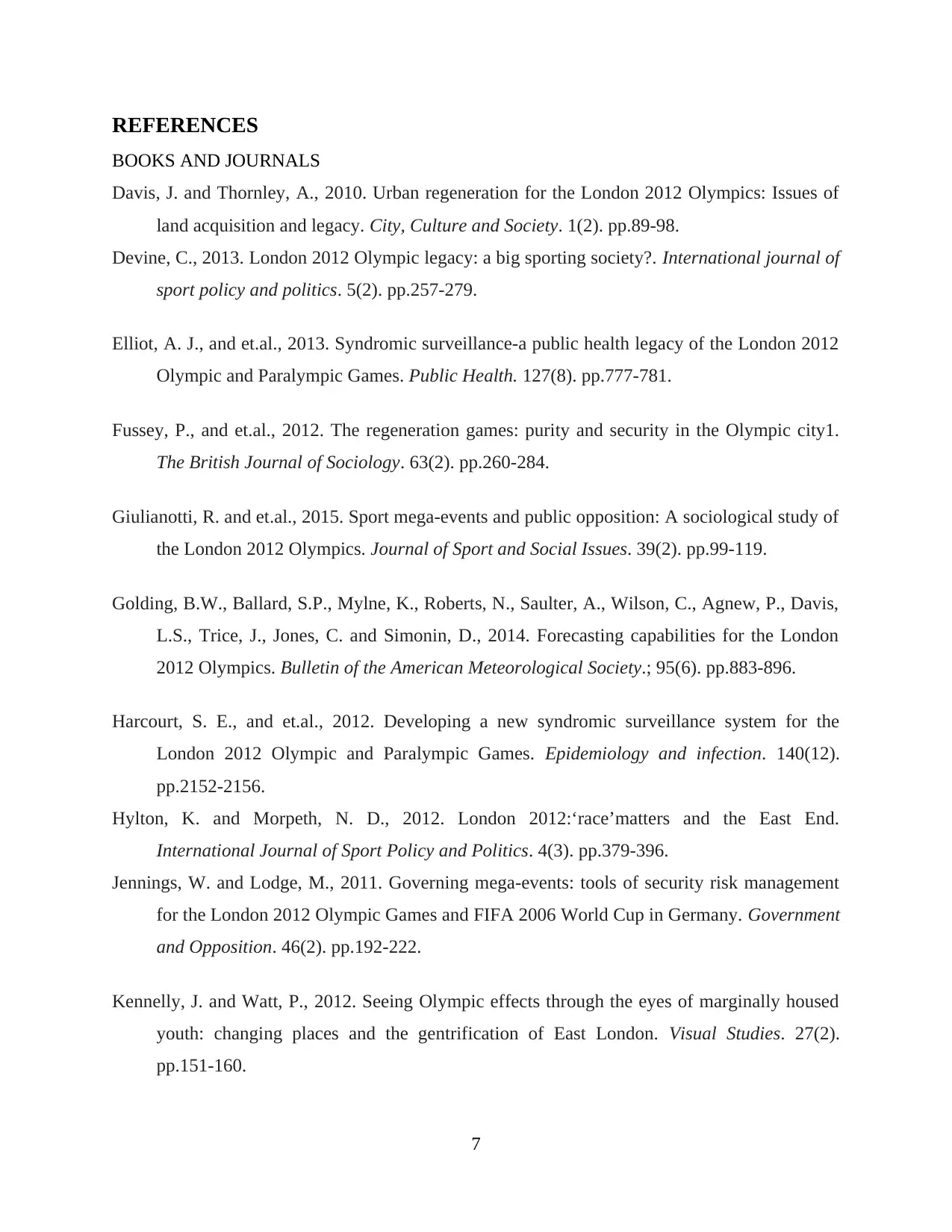
REFERENCES
BOOKS AND JOURNALS
Davis, J. and Thornley, A., 2010. Urban regeneration for the London 2012 Olympics: Issues of
land acquisition and legacy. City, Culture and Society. 1(2). pp.89-98.
Devine, C., 2013. London 2012 Olympic legacy: a big sporting society?. International journal of
sport policy and politics. 5(2). pp.257-279.
Elliot, A. J., and et.al., 2013. Syndromic surveillance-a public health legacy of the London 2012
Olympic and Paralympic Games. Public Health. 127(8). pp.777-781.
Fussey, P., and et.al., 2012. The regeneration games: purity and security in the Olympic city1.
The British Journal of Sociology. 63(2). pp.260-284.
Giulianotti, R. and et.al., 2015. Sport mega-events and public opposition: A sociological study of
the London 2012 Olympics. Journal of Sport and Social Issues. 39(2). pp.99-119.
Golding, B.W., Ballard, S.P., Mylne, K., Roberts, N., Saulter, A., Wilson, C., Agnew, P., Davis,
L.S., Trice, J., Jones, C. and Simonin, D., 2014. Forecasting capabilities for the London
2012 Olympics. Bulletin of the American Meteorological Society.; 95(6). pp.883-896.
Harcourt, S. E., and et.al., 2012. Developing a new syndromic surveillance system for the
London 2012 Olympic and Paralympic Games. Epidemiology and infection. 140(12).
pp.2152-2156.
Hylton, K. and Morpeth, N. D., 2012. London 2012:‘race’matters and the East End.
International Journal of Sport Policy and Politics. 4(3). pp.379-396.
Jennings, W. and Lodge, M., 2011. Governing mega-events: tools of security risk management
for the London 2012 Olympic Games and FIFA 2006 World Cup in Germany. Government
and Opposition. 46(2). pp.192-222.
Kennelly, J. and Watt, P., 2012. Seeing Olympic effects through the eyes of marginally housed
youth: changing places and the gentrification of East London. Visual Studies. 27(2).
pp.151-160.
7
BOOKS AND JOURNALS
Davis, J. and Thornley, A., 2010. Urban regeneration for the London 2012 Olympics: Issues of
land acquisition and legacy. City, Culture and Society. 1(2). pp.89-98.
Devine, C., 2013. London 2012 Olympic legacy: a big sporting society?. International journal of
sport policy and politics. 5(2). pp.257-279.
Elliot, A. J., and et.al., 2013. Syndromic surveillance-a public health legacy of the London 2012
Olympic and Paralympic Games. Public Health. 127(8). pp.777-781.
Fussey, P., and et.al., 2012. The regeneration games: purity and security in the Olympic city1.
The British Journal of Sociology. 63(2). pp.260-284.
Giulianotti, R. and et.al., 2015. Sport mega-events and public opposition: A sociological study of
the London 2012 Olympics. Journal of Sport and Social Issues. 39(2). pp.99-119.
Golding, B.W., Ballard, S.P., Mylne, K., Roberts, N., Saulter, A., Wilson, C., Agnew, P., Davis,
L.S., Trice, J., Jones, C. and Simonin, D., 2014. Forecasting capabilities for the London
2012 Olympics. Bulletin of the American Meteorological Society.; 95(6). pp.883-896.
Harcourt, S. E., and et.al., 2012. Developing a new syndromic surveillance system for the
London 2012 Olympic and Paralympic Games. Epidemiology and infection. 140(12).
pp.2152-2156.
Hylton, K. and Morpeth, N. D., 2012. London 2012:‘race’matters and the East End.
International Journal of Sport Policy and Politics. 4(3). pp.379-396.
Jennings, W. and Lodge, M., 2011. Governing mega-events: tools of security risk management
for the London 2012 Olympic Games and FIFA 2006 World Cup in Germany. Government
and Opposition. 46(2). pp.192-222.
Kennelly, J. and Watt, P., 2012. Seeing Olympic effects through the eyes of marginally housed
youth: changing places and the gentrification of East London. Visual Studies. 27(2).
pp.151-160.
7
Paraphrase This Document
Need a fresh take? Get an instant paraphrase of this document with our AI Paraphraser

Minton, A., 2012. Ground control. Arena Magazine (Fitzroy, Vic). (119). p.34.
Orttung, R. W. and Zhemukhov, S., 2014. The 2014 Sochi Olympic mega-project and Russia's
political economy. East European Politics. 30(2). pp.175-191.
Raco, M., 2015. Sustainable city‐building and the new politics of the possible: reflections on the
governance of the London Olympics 2012. Area. 47(2), pp.124-131.
8
Orttung, R. W. and Zhemukhov, S., 2014. The 2014 Sochi Olympic mega-project and Russia's
political economy. East European Politics. 30(2). pp.175-191.
Raco, M., 2015. Sustainable city‐building and the new politics of the possible: reflections on the
governance of the London Olympics 2012. Area. 47(2), pp.124-131.
8
1 out of 11
Related Documents
Your All-in-One AI-Powered Toolkit for Academic Success.
+13062052269
info@desklib.com
Available 24*7 on WhatsApp / Email
![[object Object]](/_next/static/media/star-bottom.7253800d.svg)
Unlock your academic potential
Copyright © 2020–2025 A2Z Services. All Rights Reserved. Developed and managed by ZUCOL.




